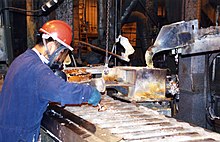Blue collar
The terms blue collar (worker) and white collar (worker) are understood to mean the industrial workers and craftsmen mostly employed in a production company on the one hand, and the office, commercial, service and similar professions on the other hand, or more generally those that are more common only in German Terms of workers and employees . The terms, which originally came from English, are now also used internationally in business administration and the social sciences . Colloquially, they find an equivalent in the pair of terms malocher / tie carrier.
(. English linguistic distinction collar, Collars') alludes to the classic working gear, respectively, the dress code of workwear to:
- blue collar: Blaumann (originally a blue overall ), work suit ; This means work clothing in practical, physical (and mostly dirty) work areas
- white collar: white shirt, suit , tie etc .; meant is office or business clothing
The Sociologie du Travail sees the traditional blouse bleu / blouse blanche classification (ouvrier / technicien, secondaire / tertiaire) increasingly being replaced by technological changes in the production process that lead to the emergence of a “new working class”.
International
In the United States, approximately 40% of the population work in blue collar jobs.
See also
Individual evidence
- ^ Charles Wright Mills : A Look at the White Collar. In: Power, Politics and People. The Collected Essays of C. Wright Mills. Oxford University Press, London Oxford New York 1952.
- ^ Serge Mallet : La nouvelle classe ouvrière. Ed. you Seuil. Paris 1969. p. 11
- ↑ Beegley, L. (2004). The Structure of Social Stratification in the United States . Boston, MA: Pearson, Allyn & Bacon.
